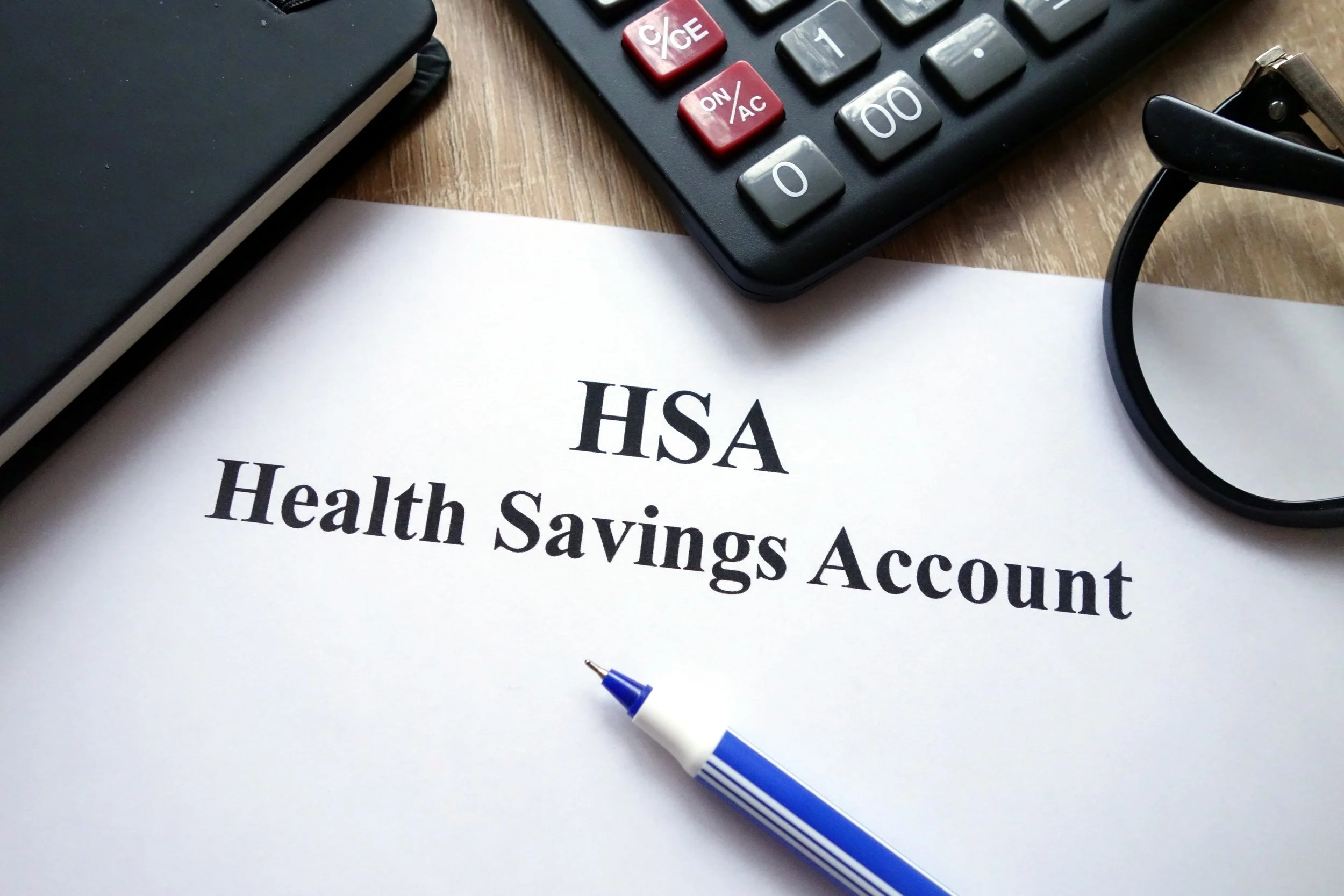3 Reasons to Open an HSA Account in 2023
As we begin the 2023, I want to ensure that you’re setting yourself up for success in 2023. A great way to do that while helping you save for retirement is opening a Health Savings Account (HSA). Throughout this blog, I’m going to breakdown the three reasons why opening an HSA account is a smart retirement planning move and how to choose the right HSA provider.
Key Takeaways:
· Why an HSA is Different Than Any Other Retirement Account
· Investing with an HSA
· Using an HSA to Reimburse Your Medical Expenses
· The Logistics of Opening an HSA
Why an HSA is Different Than Any Other Retirement Account
One of the key factors in preparing for retirement is to save enough money. However, when people hear the term “save for retirement” they often think of a 401(k), 457, or 403(b) plan. While one of the best retirement savings vehicles is overlooked and that would be the Health Savings Account known as an HSA.
The first reason to open an HSA account is to take advantage of the triple tax savings. What this means is that you will receive a deduction when you make your contribution into the HSA. Then while the money is invested, any gains, interest, or dividends received are tax-deferred as you can reinvest the amounts. Finally, the money can be withdrawn 100% tax-free if used to pay for qualified medical expenses. If the amount is not used to cover a qualified expense, then the individual will be subject to taxes on the gains in the account.
Every other retirement account that you could use would require you to pay taxes on part of the transaction. Let’s use a Traditional 401(k) and Roth IRA as an example. A Traditional 401(k) uses pre-tax contributions so there are no up-front taxes. Since no taxes were paid up-front, the future withdrawals are added to your taxable income resulting in higher taxes. To contrast, a Roth IRA requires post-tax contributions which means you have paid taxes on the money prior to it being contributed to the account. Therefore, there are no other retirement accounts quite like the HSA.
However, the HSA account does have some limitations. First, if you needed the money for other expenses before age 65, then you would be subject to a 20% penalty. These terms are harsher than taking a 401(k) distribution early (10%) so that is one negative aspect of the HSA. The other limitation occurs when you are 65 or older and have excess money in your HSA that you don’t plan to use on qualified medical expenses. In this case, the withdrawal amount would be taxed just like a 401(k) distribution so you would have to pay income tax on that amount. Regardless, I believe that the triple tax-free benefits outweigh any penalty that could occur.
The amount that you need to set aside for health-related costs varies per family. There are several factors to consider such as how many people are covered by your plan, outstanding health concerns, family history, etc. Luckily, Fidelity estimates the amount that a 65 year old couple would need to have to cover their qualified costs excluding long term care expenses. In 2022, this number was $315,000. Therefore, having money in an HSA will help cover a portion of these expenses that many couples will experience in the future.
Investing With an HSA
The second reason why an HSA is a great account is that you can invest the money. Therefore, the real benefit is the compounded earnings just like you would get in your 401(k) or Traditional IRA. Unfortunately, there are a lot of people that misuse their HSA account. They contribute money to the account each year and then let it sit until they need it to cover qualified medical expenses. These individuals are using the account as a double tax-advantaged instead of a triple tax-advantaged account because they forgo the tax-deferred benefits you receive when you invest the money.
Therefore, to fully take advantage of your HSA account you need to employ a bucket strategy. The strategy requires you allocate your HSA into short-term funds and long-term funds. The short-term funds are those you plan to use within the next year for upcoming expenses. This money should be invested into conservative and liquid investments such as a money market fund or short-term treasury bonds. The long-term funds are those that you don’t plan to use within the next year. This money should be invested with a growth focus as the money will have years to accumulate gains. Ideal investments for the long-term portion of your account would be stock funds, real estate funds, and possibly commodity funds.
The next thing that you need to think about is whether your account is paying you at least some interest. This was not a big concern in the past 20 years as interest rates were held at almost zero, so an HSA paying near zero interest rates was normal. However, things have changed a lot in 2022. You can now get a competitive rate of interest (3-4%) from an HSA account. If you can invest within your HSA, then a simple money market fund should yield these results with little to no risk. The issue is that certain HSA custodians do not allow for investments within, and if that applies to you then I suggest you transfer the account to another custodian.
I currently hold my HSA account in Fidelity. I too use the bucketing strategy that I mentioned above. The short-term funds are invested into the Fidelity Government Cash Reserve Fund (FDRXX). As of 2/15/2023, the 7-Day Yield on this account was 3.99% which net of fees (.34%) would give you an annualized return of 3.65%. As of right now, the Fidelity HSA has 30 investment options including stock, bond, Target Date, and Money Market funds. For your long-term funds, I would suggest that you invest in the stock funds. These are mutual funds so you get exposure to several underlying positions, but I would suggest you diversify across market capitalizations and location (domestic vs. international).
Morningstar releases an annual report that reviews the HSA landscape. The 2022 report was released in September, so I would assume that the 2023 report will be released later this year. The report claimed that according to Fidelity, most people with an HSA through them leave their money in one of the default cash accounts. While another HSA provider, HAS Authority, reported that only one in twenty-nine people have invested the money in their HSA. These are disappointing figures as only 3.5% of people are taking advantage of all the tax benefits offered by an HSA. All these individuals need to do is follow a few steps and they could improve their 0-.5% annual return on their HSA to 3%+.
The report does not include HSAs provided by employers. The main reason that people get an HSA is because they are on a high-deductible health plan through work (voluntary or involuntary) so they offer you an HSA. The benefit to these people is that they don’t have to keep their money in that specific HSA if they don’t like the yield that they have received or the available investment options. The HSA should have at least one large-cap, one mid-cap, one small-cap, one international, one real estate, one intermediate bond fund, and a money market fund. If these options are not available, then it would be wise to transfer your HSA elsewhere so you can take advantage of the increased diversification.
The expense ratios on your available investments could be another reason to transfer your HSA to another custodian. An expense ratio is the cost the investor may pay on an annual basis to hold the fund which pays for things such as management, administration, marketing, etc. Typically, index funds will have low expense ratios. Many of the largest index fund providers charge 1/10th of a percent (0.1%) or less. Therefore, you should aim to invest in funds that are going to provide consistent returns and charge low annual fees.
If you have a 401(k), then there are limitations when it comes to transferring your account as you must wait until you reach age 59 and a half or separate from the company. A benefit of an HSA is that there are no transfer restrictions. You can easily transfer your HSA elsewhere if you are unhappy with the investment options or fees. So instead of settling for a sub-par HSA, go out and find a better one.
Using an HSA to Reimburse Your Medical Expenses
The third reason that you should open an HSA account is that you can reimburse yourself at any age with an HSA account. Unfortunately, many HSA holders will use their HSA as a checking account. They deposit money into the account and then withdraw it whenever they have to go to the doctor and incur qualified medical expenses. This method does not realize one of the three tax advantages of the account.
Instead, HSA owners should keep track of the qualified medical expenses that they incur and pay for them out-of-pocket in the moment. The individual can reimburse themselves at any time as long as the expenses occurred while covered by a high-deductible health plan. They could pay for all their qualified medical expenses for years and reimburse themselves years later as long as they have documented the date, amount, and what type of expense. This way the investor can take advantage of the three tax advantages provided by an HSA and save some money.
Let’s say you opened an HSA account ten years ago. You have continued to make contributions to the account and have not made any withdrawals yet. Over the past ten years, this individual has kept track of the qualified medical expenses that they opted to pay for out-of-pocket in an Excel spreadsheet. Now the HSA has grown to $50,000 and they have incurred $25,000 worth of qualified medical expenses over the past 10 years. That individual can now withdraw $25,000 tax-free anytime in the future to reimburse themself for the ten years of expenses they opted to pay for themselves. This is the best way to use an HSA, the one thing you need to remember is that those accumulated expenses must have been incurred during periods where the investor was covered by a high-deductible health plan.
The Logistics of Opening an HSA
Now that you’ve read about the reasons to open an HSA, let’s cover some of the logistics you need to know before doing so. The first thing is that HSAs are only available to those covered by a high-deductible health plan. According to Morningstar, 21% of workers were covered by a high-deductible health plan in 2021. This is not a large percentage, and I would assume that many workers do not realize they can open an HSA or neglect doing so because they do not understand the benefits. My recommendation is that individuals unclear of their status should reach out to their employer to find out if they qualify.
The next thing to note are the contribution limits in 2023. An individual can contribute $3,850 per year while a family can contribute $7,700 per year. There is a $1,000 catch-up contribution for those age 55. Both spouses can make the catch-up contribution in a year, but it would require the second spouse to open their own HSA which is not a big deal. Keep in mind, these limit include any contributions made by your employer. If they wanted to contribute $1,500 per year to your HSA, then you would have to reduce your contribution by $1,500. You do not want to contribute more than the maximum to your HSA.
There are two options for those who contribute above the maximum to their HSA. The first option is to withdraw the excess contributions from your account. This will incur income taxes on the amount and must be done before federal income tax filing of that year. The second option is to leave the excess contributions in the account and pay a 6% excise tax on the excess amount. In the next year, the individual should reduce their contribution by the excess amount contributed in the year prior.
Next, there are situations where it makes sense for individuals to change to a high-deductible health plan. Imagine that the premium for a high-deductible plan is $500 cheaper than the POS plan you currently have. If you were to invest that $500 of savings into your HSA each month then you would accumulate $6,000 into the account. Now let’s imagine that your family is relatively healthy and only incurred $2,000 worth of medical expenses over the year. After reducing the amount for expenses, the individual would have saved $4,000 that he/she would not have had otherwise. On top of that, the money is now invested in an account that is triple-tax advantaged, so it made sense for said individual to switch to the high-deductible plan.
However, it does not make sense for everyone to switch to an HSA. If you predict that you will incur a lot of medical expenses, then a high-deductible health plan is likely not for you. With a high-deductible health plan, the individual will have to cover all medical expenses until they reach the “high” deductible.
For example, let’s say the deductible on the high-deductible health plan is $10,000. The switch to the high-deductible health plan from the POS plan saved you $500 per month in premiums. Additionally, the individual’s family experienced a lot of health issues in the year and caused them to meet the deductible. Instead of increased savings like the scenario above, this individual would have a significant loss. They saved $6,000 but spent $10,000 to meet the deductible so they would have lost $4,000 by switching to a high-deducible health plan in that year. Therefore, there are many factors you need to evaluate before switching health plans as there is risk involved.
Morningstar published a list of HSA providers that they ranked based on their own criteria. This would include the ability to save in the HSA which considers the available money market fund and expenses, as well as the ease of transferring the money in or out of the account. Under these metrics, Morningstar concluded that the Fidelity HSA was the best available and gave it a 5/5 rating. If you follow my works, then you should not be shocked as I use the Fidelity HSA myself and recommend it to my clients. The next two HSA providers were American Bank and HSA Bank which both received ratings of 4.4/5.
They also rank the HSA providers on the available investment options which includes the fund selection, expense ratios, diversification, and whether they charge you to have the invest the account. Again, Fidelity was given the top spot with a rating of 4.4/5. The second ranked HSA on this list was HealthEquity with a score of 4.2/5. Which means that Fidelity should be viewed as the best HSA provider as they were ranked #1 on both published lists by Morningstar. Therefore, if you consider opening or transferring an HSA, then I would recommend you do this through Fidelity.
If you are interested in learning more ways to save for retirement then I would recommend listening to my weekly podcast, Retire with Ryan. Additionally, if you are looking for specific recommendations then I would suggest you schedule your Free Retirement Assessment on my website, Morrissey Wealth Management.


